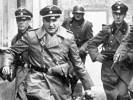Eye For Film >> Movies >> Schindler's List (1993) Film Review
Schindler's List
Reviewed by: Scott Macdonald

Schindler : "What's one person worth to you?"
Goeth : "No... What's one worth to you?"
The central conceit of Schindler's List can be summarised in a single conversation. It is to Steven Spielberg's credit that everything afterwards develops this theme to some degree or another, without overt labouring. Spielberg held on to Thomas Keneally's famous non-fiction work, Schindler's Ark, for more than ten years - it was to be his next project after the glorious E.T. - before he felt ready to attack the subject matter of the Holocaust. His development as a filmmaker pays off enormously in an astonishing motion picture.

Neeson's Schindler is a remarkably realised performance; it's subtlety almost aggravating, we want to know what makes him do as he does, but the story only lets us see a small fragment of his motivation. What causes him to change from a man who manipulates the Jews into the saviour of generations? A man whose innermost thoughts are so buried it's impossible to see the purpose without standing back and looking at the events from a distance. Spielberg does this, but remains intimate with Schindler's workers. The scene where the workers present their rescuer with a gold ring bearing the inscription from the Tablet "he who saves one life saves the world entire", representing their combined thanks, is a masterstroke. Their gratitude is beyond words, so it is conveyed with Schindler's face, as he holds the ring, fumbles and drops it. He shakingly picks it back up, and looks up at his workers. Look at his face - he's only just in control of himself. It's a revelatory emotional moment, and Neeson makes it his own. And then his guilt about "just one more person" remains as startling and shocking. "What's one person worth to you?"
As his conscience and accountant, Itzhak Stern, Ben Kingsley delivers a powerfully internalised performance. His constant gentle prodding of Schindler's morals, from refusing to share in his unbridled joy at unfairly conniving against his Jewish investors, to hammering home just what happens behind the walls of the forced labour camp gradually wears away at him. Stern remains there for him as penance. He is both "a forgiving priest and a clever accountant."
The third accomplished performance comes from Ralph Fiennes as a monster of a man, Amon Goeth. His life is a series of indulgences: women, food (Fiennes gained 30lbs drinking Guinness), and murder. The commandante persona is a paper-thin disguise for a pathologically ill murderer enjoying the banality of his excessively masterial existence. He lives in a spectacular villa, served by his hand-picked beautiful Jewish woman - lightened only for a split-second with trigger pulls, and yet another bleeding soon-lifeless lump of flesh. Janusz Kaminski's camera captures this with the unblinking ferocity of documentary - Goeth taking pot-shots at workers for target practice, blasting two dozen workers for an attempted escape, and so on. The inky black blood of the workers hammers home the injustices.
The traits of Spielberg are in full force: the ordinary person fighting for what he believes in, his unspeakably precocious manipulative camerawork and editing. He milks the viewer for sympathy and it comes readily. The Jews remain an ensemble character amalgamation, with only unique faces standing out.
Some critics have thinly attacked the film by comparing the horror set-pieces in both Schindler's List and Saving Private Ryan to cathartic theme park rides, succeeding through sheer manipulative means. I prefer to argue that by placing the viewer in the moment, Spielberg shows his skill as storyteller, never failing to make the sympathetic characters anything less than that. Through his intimacy with them, he humanises the mass persecuted alarmingly. Note the entire Auschwitz sequence, where the workers are delivered to the gates of hell. The freezing cold, blinding spotlights transform faces into ghost-figures; the all-consuming ovens vomit human ash; we imagine Cerberus-like hellhounds and the previously told stories about mass-gassing. It builds and builds to staggering effect.
Another of Spielberg's great horror setpieces is the 17-minute gruelling ghetto massacre scene, a masterly and awful piece of gritty and grainy black and white art. It is the first real appearance and use of colour. A girl in red symbolises Schindler's focus on an individual. He and his wife look on from afar as this young girl, subtly tinted, walks through the execution-style murders looking for a place to hide. Her red coat is seen again in the stunning immolation scene. It is the catalyst for Schindler's efforts to save as many as he can: by humanising the girl as an individual, he can apply her needs to the entire faceless mass. Why did Spielberg choose to highlight the colour red? I believe that he wanted to hit home just what was happening, by making the girl's coat representative of a bloody smear, a passionate cry for aid that went unheard as the war was continuing on other fronts.
His ending provides closure, if not comfort. It is not a happy ending, but an affirming one, in that it shows that it is possible to reject mass genocide and that good men can save the world entire. Lists bookend the film: the condemned, and eventually a few of those saved. It is a horrific irony that the film explains there are 6,000 descendents of the Schindler Jews. Schindler did more in eight months, than Poland could in 50 years.
Reviewed on: 23 Dec 2006

















